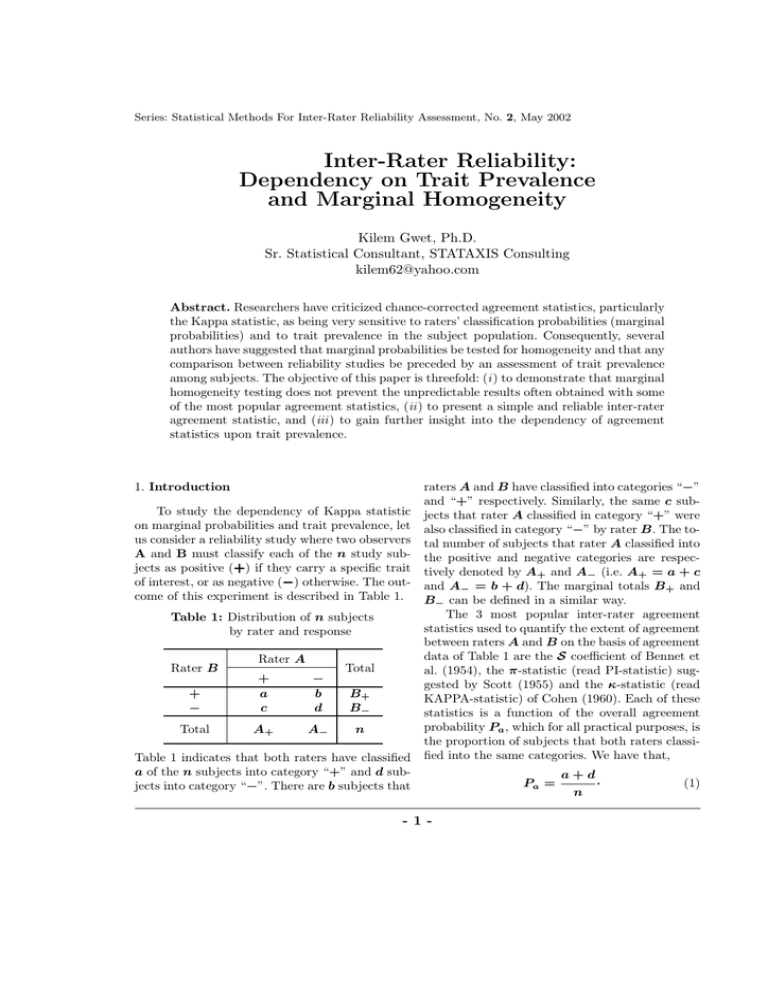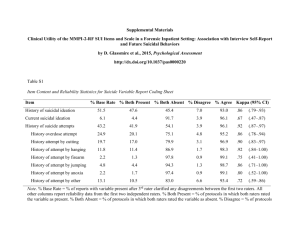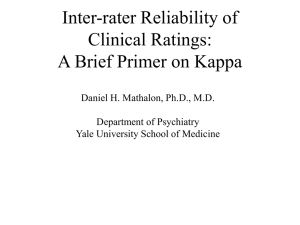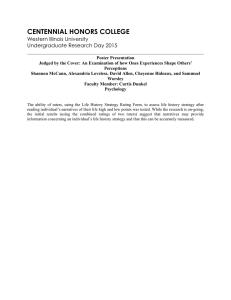Inter-Rater Reliability: Dependency on Trait Prevalence and Marginal Homogeneity Kilem Gwet, Ph.D.
advertisement

Series: Statistical Methods For Inter-Rater Reliability Assessment, No. 2, May 2002 Inter-Rater Reliability: Dependency on Trait Prevalence and Marginal Homogeneity Kilem Gwet, Ph.D. Sr. Statistical Consultant, STATAXIS Consulting kilem62@yahoo.com Abstract. Researchers have criticized chance-corrected agreement statistics, particularly the Kappa statistic, as being very sensitive to raters’ classification probabilities (marginal probabilities) and to trait prevalence in the subject population. Consequently, several authors have suggested that marginal probabilities be tested for homogeneity and that any comparison between reliability studies be preceded by an assessment of trait prevalence among subjects. The objective of this paper is threefold: (i ) to demonstrate that marginal homogeneity testing does not prevent the unpredictable results often obtained with some of the most popular agreement statistics, (ii ) to present a simple and reliable inter-rater agreement statistic, and (iii ) to gain further insight into the dependency of agreement statistics upon trait prevalence. 1. Introduction To study the dependency of Kappa statistic on marginal probabilities and trait prevalence, let us consider a reliability study where two observers A and B must classify each of the n study sub+) if they carry a specific trait jects as positive (+ −) otherwise. The outof interest, or as negative (− come of this experiment is described in Table 1. Table 1: Distribution of n subjects by rater and response Rater B Rater A + − + a c − b d Total A+ A− Total B+ B− n Table 1 indicates that both raters have classified a of the n subjects into category “+” and d subjects into category “−”. There are b subjects that raters A and B have classified into categories “−” and “+” respectively. Similarly, the same c subjects that rater A classified in category “+” were also classified in category “−” by rater B. The total number of subjects that rater A classified into the positive and negative categories are respectively denoted by A+ and A− (i.e. A+ = a + c and A− = b + d). The marginal totals B+ and B− can be defined in a similar way. The 3 most popular inter-rater agreement statistics used to quantify the extent of agreement between raters A and B on the basis of agreement data of Table 1 are the S coefficient of Bennet et al. (1954), the π-statistic (read PI-statistic) suggested by Scott (1955) and the κ-statistic (read KAPPA-statistic) of Cohen (1960). Each of these statistics is a function of the overall agreement probability Pa , which for all practical purposes, is the proportion of subjects that both raters classified into the same categories. We have that, -1- Pa = a+d n · (1) -2- I.R.R: Dependency on Trait Prevalence and Marginal Homogeneity The inter-rater reliability as measured by the Scoefficient is defined as follows: S = 2Pa − 1· (2) Scott’s π-statistic is given by: PI = Pa − Pe (π) 1 − Pe (π) , (3) where Pe (π) measures the likelihood of agreement by chance. Using the information contained in Table 1, Pe (π) is expressed as follows: 2 2 Pe (π) = P+ + P− , (4) £ ¤ where P = (A + B )/2 /n and P− = + + + £ ¤ (A− + B− )/2 /n. Some authors have mistakenly criticized Scott’s π-statistic by claiming it was developed under the assumption of marginal homogeneity. The quantity P+ should not be interpreted as a common probability that each rater classify a subject into the positive category. It should rather be interpreted as the probability that a randomly chosen rater (A or B) classify a randomly chosen subject into category “+”. The probability P− can be interpreted in a similar way. This interpretation, also suggested by Fleiss (1971) seems to be consistently misunderstood. Cohen’s κ-statistic is given by: KA = Pa − Pe (κ) 1 − Pe (κ) , (5) where Pe (κ) provides Cohen’s measure of the likelihood of agreement by chance. Using the information contained in Table 1, Pe (κ) can be expressed as follows: Pe (κ) = PA+ PB+ + PA− PB− , (6) where PA+ = A+ /n, PA− = A− /n, PB+ = B+ /n, and PB− = B− /n. Cohen’s Kappa statistic uses rater-specific classification probabilities PA+ , PA− , PB+ , and PB+ to compute the likelihood of agreement by chance, while Scott’s approach is based on the overall classification probabilities P+ and P− . 2. Dependency of Agreement Measures on Bias and Prevalence The 2 basic questions one should ask about any inter-rater reliability statistic are the following: • Does the statistic provide a measure of the extent of agreement between raters that is easily interpretable? • How precise are the methods for obtaining them? We believe that while the limitations of agreement statistics presented in the literature are justified and should be addressed, many researchers have had a tendency of placing unduly high expectations upon chance-corrected agreement measures. These are summary measures, intended to provide a broad picture of the agreement level between raters and cannot be used to answer each specific question about the reliability study. Agreement statistics can and should be suitably modified to address specific concerns. Cicchetti and Feinstein (1990) pointed out the fact that a researcher may want to know what was found for agreement in positive and negative responses. This is a specific problem that could be resolved by conditioning any agreement statistic on the specific category of interest (see Gwet (2001), chapter 8). The PI and Kappa statistics are two chancecorrected agreement measures that are highly sensitive to the trait prevalence in the subject population as well as to differences in rater marginal probabilities PA+ , PA− , PB+ , and PB− . These 2 properties make the PI and Kappa statistics very unstable and often difficult to interpret. The S coefficient is also difficult to interpret for different reasons that are discussed in subsequent sections. This section contains a few examples of inter-rater reliability experiments where interpreting these statistics is difficult. c 2002 by Kilem Gwet, Ph.D., All Rights Reserved Copyright ° Kilem Gwet Let us consider a researcher who conducted 4 inter-rater reliability experiments (experiments E1, E2, E3, E4) and reported the outcomes respectively in Tables 2, 3, 4, and 5. Marginal totals in Table 2 suggest that raters A and B tend to classify subjects into categories with similar frequencies. Marginal totals in Table 3 on the other hand, indicate that rater B is much more likely to classify a subject into the positive category than rater A, who in turn (a fortiori) is more likely to classify a subject into the negative category. Most researchers would prefer in such situations, an agreement statistic that would yield a higher inter-rater reliability for experiment E1 than for experiment E2. By favoring the opposite conclusion, neither Scott’s PI statistic nor Cohen’s Kappa statistic are consistent with this researchers’ expectation. The S coefficient gives the same inter-rater reliability for both experiments and does not satisfy that requirement either. Note that raters A and B in experiments E1 and E2 have the same overall agreement probability Pa = (45 + 15)/100 = (25 + 35)/100 = 0.6. • For experiment E1 (Table 2), we have that P+ = [(60+70)/2]/100 = 0.65 and P− = [(40 + 30)/2]/100 = 0.35, which leads to a chance-agreement probability Pe (π) = (0.65)2 + (0.35)2 = 0.545, according to Scott’s method. Therefore, the PI statistic is given by: PI = (0.6 − 0.545)/(1 − 0.545) = 0.1209. To obtain the Kappa statistic, one would notice that chance-agreement probability according Cohen’s method is given by Pe (κ) = 0.60 × 0.70 + 0.40 × 0.30 = 0.54. This leads to a Kappa statistic KA = (0.60 − 0.54)/(1 − 0.54) = 0.1304. • For experiment E2 (Table 3), we have that P+ = [(60 + 30)/2]/100 = 0.45 and P− = [(40 + 70)/2]/100 = 0.55, which leads to Scott’s chance-agreement probability of Pe (π) = (0.45)2 + (0.55)2 = 0.505. Therefore, the PI statistic is given by: P I = (0.6 − 0.505)/(1 − 0.505) = 0.1920. -3- For this experiment (E2), chanceagreement probability according to Cohen’s proposal is Pe (κ) = 0.60 × 0.30 + 0.40 × 0.70 = 0.46. This leads to a Kappa statistic of KA = (0.60 − 0.46)/(1 − 0.46) = 0.2593. While most researchers would expect the extent of agreement between raters A and B to be higher for experiment E1 than for experiment E2, the 2 most popular inter-rater agreement statistics reach a different conclusion. This unwanted dependency of chance-corrected statistics on the differences in raters’ marginal probabilities is problematic and must be resolved to reestablish the credibility of the idea of correcting for agreement by chance. This problem is formally studied in section 3 where we make some recommendations. Table 2: Distribution of 100 subjects by rater and response: experiment E1 Rater B Rater A Total + − + 45 15 60 − 25 15 40 Total 70 30 100 Table 3: Distribution of 100 subjects by rater and response: experiment E2 Rater B Rater A Total + − + 25 35 60 − 5 35 40 Total 30 70 100 For experiments E3 and E4 (Tables 4 and 5), the raters have identical marginal probabilities. Table 4 indicates that raters A and B in experiment E3 will both classify a subject into either c 2002 by Kilem Gwet, Ph.D., All Rights Reserved Copyright ° -4- I.R.R: Dependency on Trait Prevalence and Marginal Homogeneity category (“+” or “−”) with the same probability of 50%. Similarly, it follows from Table 5 that raters A and B in experiment E4 would classify a subject into the positive category with the same probability of 80% and into the negative category with the same probability of 20%. Because the raters have the same propensity for positive (and a fortiori negative) rating in these 2 experiments, researchers would expect them to have high interrater reliability coefficients in both situations. The Kappa and PI statistics have failed again to meet researchers’ expectations in the situations described in Tables 4 and 5, where the overall agreement probability Pa is evaluated at 0.8. • For experiment E3 (Table 4), we have P+ = P− = [(50 + 50)/2]/100 = 0.50. This leads to a Scott’s chance-agreement probability of Pe (π) = (0.5)2 + (0.5)2 = 0.5. Thus, the PI statistic is given by: PI = (0.8 − 0.5)/(1 − 0.5) = 0.60. The Kappa statistic is obtained by first calculating Cohen’s chance-agreement probability Pe (κ) as follows: Pe (κ) = 0.5 × 0.5+0.5×0.5 = 0.5. This leads to a Kappa statistic that is identical to the PI statistic obtained in the previous paragraph (i.e. KA = 0.60). • For experiment E4 (Table 5), we have that P+ = [(80 + 80)/2]/100 = 0.80 and P− = [(20 + 20)/2]/100 = 0.20, which leads to Scott’s chance-agreement probability of Pe (π) = (0.8)2 + (0.2)2 = 0.68. Thus, the PI statistic is given by: PI = (0.8 − 0.68)/(1 − 0.68) = 0.375. Using Cohen’s approach, chance-agreement probability is obtained as follows: Pe (κ) = 0.8×0.8+0.2×0.2=0.68. Again, the Kappa statistic is identical to the PI statistic and given by KA = 0.375. It appears from Tables 4 and 5 that even when the raters share the same marginal probabilities, the prevalence of the trait in the population may dramatically affect the magnitude of the interrater reliability as measured by the Kappa and PI statistics. In fact, there is no apparent reason why Tables 4 and 5 would not both yield high agreement coefficients. One would expect a lower chance-agreement probability from Table 5, as both raters appear to be more inclined to classify subjects into the positive category, leading to an agreement coefficient that is higher for Table 5 than for Table 4. Table 4: Distribution of 100 subjects by rater and response: experiment E3 Rater B Rater A Total + − + 40 10 50 − 10 40 50 Total 50 50 100 Table 5: Distribution of 100 subjects by rater and response: experiment E4 Rater B Rater A Total + − + 70 10 80 − 10 10 20 Total 80 20 100 Until now, we have been focussing on the deficiencies of Kappa and PI statistic, and we have said very little about the performance of the S coefficient. Although the S coefficient is not affected by differences in marginal probabilities, nor by the trait prevalence in the population under study, it suffers from another equally serious problem. In fact, the extent of agreement between 2 raters obtained with the S coefficient will always be 0 or close to 0 if both raters agree about 50% of the times, and will be negative whenever they classify less than 50% of subjects into the same category. c 2002 by Kilem Gwet, Ph.D., All Rights Reserved Copyright ° Kilem Gwet This is a major limitation since the correct classification of 50% of subjects should indicate some agreement level between the 2 raters. The examples presented in this section were necessary to point out some unexpected results that one may get when the inter-rater agreement measures proposed in the literature are used. The next section is devoted to a deeper analysis of these problems. 3. Sensitivity Analysis and Alternative Agreement Measure In section 2, we have discussed about the limitations of the most popular inter-rater agreement statistics proposed in the literature. The goal in this section is to show how the AC 1 statistic introduced by Gwet (2002) resolves all the problems discussed in section 2, and to conduct a formal analysis of the sensitivity of agreement indices to trait prevalence and marginal differences. The AC 1 statistic is given by: Pa − Pe (γ) 1 − Pe(γ ) , (7) where Pe (γ) is defined as follows: Pe (γ) = 2P+ (1 − P+ ). agreement coefficients. It can be verified that Pe (γ) = 0.5 for Table 4 and Pe (γ) = 0.32 for Table 5. This leads to an AC 1 statistic of 0.6 and 0.71 for Tables 4 and 5 respectively. Although both Tables show the same overall agreement probability Pa = 0.80, the high concentration of observations in one cell of Table 5 has led to a smaller chance-agreement probability for that Table. Thus, the resulting agreement coefficient of 0.71 is higher than that of Table 4. Unlike the Kappa and PI statistics, the AC 1 statistic provides results that are consistent with what researchers expect. 3.1 Sensitivity to Marginal Homogeneity To study the sensitivity of Kappa, PI, and AC 1 statistics to the differences in marginal probabilities, we have conducted an experiment where the overall agreement probability Pa is fixed at 0.80, and the value a of the (+,+) cell (see Table 1) varies from 0 to 0.80 by increment of 0.10. The results are depicted in figure 1, where the variation of the 3 agreement statistics is graphically represented as a function of the overall probability P+ (P+ = (A+ + B+ )/2) of classification into the positive category. (8) We believe that the AC 1 statistic overcomes all the limitations of existing agreement statistics, and should provide a valuable and more reliable tool for evaluating the extent of agreement between raters. It was extended to more general multiple-rater and multiple-item response reliability studies by Gwet (2002), where precision measures and statistical significance are also discussed. For the situations described in Tables 2 and 3, it is easy to verify that Pe (γ) takes respectively the values of 0.455 and 0.495, leading to an AC 1 statistic of 0.27 and 0.21. As one would expect from the marginal differences, the outcome of experiment E1 yields a higher inter-rater reliability than the outcome of experiment E2. As mentioned earlier, Tables 4 and 5 describe 2 situations where researchers would expect high Inter-Rater Reliability AC 1 = -5- 0.80 0.70 0.60 0.50 0.40 0.30 0.20 0.10 0.00 -0.10 -0.20 Kappa PI AC1 0.10 0.30 0.50 P+ 0.70 0.90 Figure 1: Kappa, PI, and AC 1 statistics as a function of P+ , when Pa = 0.80. Note that for a given value of Pa , there is a one-to-one relationship between P+ and the PI statistic on one hand, and between P+ and c 2002 by Kilem Gwet, Ph.D., All Rights Reserved Copyright ° I.R.R: Dependency on Trait Prevalence and Marginal Homogeneity the AC 1 statistic on the other hand. However, each value of P+ is associated with 5 different pairs (A+ , B+ ) that will yield 3 values for the Kappa statistic. This explains the presence on the graph of 3 points N corresponding to the kappa values associated with each value of P+ . For example, when P+ = 0.1, the © pair (A+ , B+ ) will take one of the values (0.0, 0.20),ª(0.05, 0.15), (0.10, 0.10), (0.15, 0.05), (0.20, 0.00) , leading to Kappa values of 0, 0.0811,-0.1111,-0.0811, and 0 respectively. Several remarks can be made about figure 1. • Figure 1 indicates that when the overall propensity of positive rating P+ is either very small or very large, the Kappa and PI statistics tend to yield dramatically low agreement coefficients, wether marginal probabilities are identical or not. Therefore, the commonly-accepted argument according to which agreement data should be tested for marginal homogeneity before using chance-corrected agreement statistics is misleading. In fact, marginal homogeneity does not guarantee the validity of the results. • All 3 agreement statistics represented in figure 1 take a common value of 0.60 only when A+ = B+ = 0.5. When both marginal probabilities are not identically equal to 0.5, but are close enough to 0.5, all 3 statistics will still yield very similar agreement levels. • In this experiment, the agreement probability Pa was fixed at 0.80, which is expected to yield a high inter-rater reliability. Only the AC 1 statistic consistently gives a high agreement coefficient. The S coefficient was not used in this experiment as it takes the same value of 0.6 for all P+ . A very low or very high value for P+ is characterized by a high concentration of observation in one table cell. This should reduce the magnitude of chance-agreement probability, leading to a higher inter-rater reliability. Only the AC 1 statistic seems to capture this phenomenon. For comparability, we have changed the value of Pa from 0.8 to 0.6 so that we can observe how the graph in figure 1 would be affected. The results shown in figure 2, lead to the same conclusions as in figure 1. 0.50 Inter-Rater Reliability -6- 0.40 0.30 0.20 0.10 0.00 Kappa PI AC1 -0.10 -0.20 -0.30 0.20 0.40 0.60 0.80 P+ Figure 2: Kappa, PI, and AC 1 statistics as a function of P+ , when Pa = 0.60. 3.2. Sensitivity to Trait Prevalence To evaluate how sensitive the AC 1 , S, KA, and PI statistics are to the prevalence of a trait in the population, it is necessary to introduce 2 concepts often used in epidemiology: the sensitivity and the specificity of a rater. These concepts are introduced under the assumption that there exists a “gold standard” that provides the “correct” classification of subjects. The sensitivity associated with a rater A and denoted by αA , is the conditional probability that the rater correctly classify a subject into the positive category. It represents the propensity of a rater to identify positive cases. The specificity associated with a rater A and denoted by βA , is the conditional probability that the rater correctly classify a subject into the negative category. It represents the propensity of a rater to identify negative cases. The prevalence of trait in a subject population, denoted by Pr , is the probability that a randomly chosen subject from the population turn c 2002 by Kilem Gwet, Ph.D., All Rights Reserved Copyright ° Kilem Gwet out to be positive. For all practical purposes, it represents the proportion of positive cases in the subject population. To study how trait prevalence affects agreement statistics, we must assign a constant value to each rater’s sensitivity and specificity so as to obtain the expected extent of agreement between raters. Let PA+ and PB+ denote respectively the probabilities that raters A and B classify a subject as positive. Using standard probabilistic considerations, these 2 probabilities can be expressed as follows: PA+ PB+ = Pr αA + (1 − Pr )(1 − βA ), (9) = Pr αB + (1 − Pr )(1 − βB ). (10) For given values of Pr , αA , αB , βA and βB , the expected marginal totals A+ and B+ of the positive category (see Table 1) are obtained as, A+ = nPA+ and B+ = nPB+ . Moreover, raters A and B will both classify a subject as positive with a probability P++ that is given by: P++ = Pr αA αB + (1 − Pr )(1 − βA )(1 − βB ) (11) The probability for both raters to classify a subject into the negative category (“−”) is given by: ´ ³ (12) P−− = 1 − PA+ + PB+ − P++ . Since the overall agreement probability Pa that goes into the calculation of all agreement statistics is the sum of P++ and P−− , we can compute the Kappa, PI, S and AC 1 statistics as functions of prevalence (Pr ) using equations 9, 10, 11, and 12 for preassigned values of raters’ sensitivity and specificity. Some researchers see the dependence of chance-corrected agreement statistics on trait prevalence as a drawback. We believe that it is not. What is questionable, is the nature of the relationship between KA or PI statistics and trait prevalence. A good agreement measure should have certain properties that are suggested by common sense. For example, -7- 1. If raters’ sensitivity and specificity are all equal and are high, then the inter-rater reliability should be high when the trait prevalence is either low or high. 2. If raters’ sensitivity is smaller than their specificity, then one would expect a higher inter-rater reliability when the trait prevalence is small. 3. If raters’ sensitivity is greater than their specificity, then one would expect a higher inter-rater reliability when the trait prevalence is high. One should note that a high sensitivity indicates that the raters easily detect positive cases. Therefore, high sensitivity together with high prevalence should lead to high inter-rater reliability. This explains why the inter-rater reliability should have the 3 properties stated above to be easily interpretable. Unfortunately, Kappa and PI statistics do not have any of these properties. The S coefficient have these properties but will usually underestimate the extent of agreement between the raters, while the AC 1 statistics have all these properties in addition to providing the right correction for chance agreement. To illustrate the dependency of the various agreement statistics upon prevalence, we have preassigned a constant value of 0.9 to raters’ sensitivity and specificity and let the prevalence rater Pr vary from 0 to 1 by increment of 0.10. The agreement statistics were obtained using equations 9, 10, 11, 12, and the results reported in Table 6. These results are depicted in figure 3, where the inter-rater reliability coefficients as measured by Pa , S, KA, PI, and AC 1 , are plotted against trait prevalence. It follows from Table 6 that when the raters’ sensitivity and specificity are equal to 0.9, then the expected overall agreement probability Pa will take a unique value of 0.82. Kappa and PI statistics take identical values that vary from 0 to 0 with a maximum of 0.64 when the prevalence rate is at 0.5. The behavior of Kappa and PI statistics is difficult to explain. In fact, with c 2002 by Kilem Gwet, Ph.D., All Rights Reserved Copyright ° -8- I.R.R: Dependency on Trait Prevalence and Marginal Homogeneity a prevalence of 100% and high raters’ sensitivity and specificity, Kappa and PI still produce an inter-rater reliability estimated at 0. Inter-Rater Reliability Table 6: Inter-Rater Agreement as a Function of Prevalence when αA = αB = βA = βB = 0.9 Pr Pa KA PI AC 1 S 0.00 0.01 0.05 0.10 0.20 0.30 0.40 0.50 0.60 0.70 0.80 0.90 0.95 0.99 1.00 0.82 0.82 0.82 0.82 0.82 0.82 0.82 0.82 0.82 0.82 0.82 0.82 0.82 0.82 0.82 0.00 0.07 0.25 0.39 0.53 0.60 0.63 0.64 0.63 0.60 0.53 0.39 0.25 0.07 0.00 0.00 0.07 0.25 0.39 0.53 0.60 0.63 0.64 0.63 0.60 0.53 0.39 0.25 0.07 0.00 0.78 0.78 0.76 0.74 0.71 0.67 0.65 0.64 0.65 0.67 0.71 0.74 0.76 0.78 0.78 0.64 0.64 0.64 0.64 0.64 0.64 0.64 0.64 0.64 0.64 0.64 0.64 0.64 0.64 0.64 0.90 0.80 0.70 0.60 0.50 0.40 0.30 0.20 0.10 0.00 AC1 PI Ka S Pa 0.00 0.20 0.40 0.60 prevalence 0.80 1.00 Figure 3: Pa , S, Kappa, PI, and AC 1 statistics as a function of Pr , when αA = αB = βA = βB = 0.90. The S coefficient’s curve is parallel to that of Pa as it applies a uniform maximum chanceagreement correction of 0.5. The AC 1 will usually take a value between Pa and S after applying an optimum correction for chance agreement. In Table 7, we assumed that the raters have a common sensitivity of 0.8 and a common specificity of 0.9. Kappa and PI statistics vary again from 0 to 0 with a maximum of 0.50 reached at a prevalence rate of 0.4. For reasons discussed in the last paragraph, this behavior is not consistent with any expectations based on common sense. The scattered plot corresponding to Table 7 is shown in figure 4, where the AC 1 line is located between that of the agreement probability Pa and that of the S coefficient. Table 7: Inter-Rater Agreement as a Function of Prevalence when αA = αB = 0.8 and βA = βB = 0.9 Pr Pa KA PI AC 1 S 0.00 0.01 0.05 0.10 0.20 0.30 0.40 0.50 0.60 0.70 0.80 0.90 0.95 0.99 1.00 0.82 0.82 0.81 0.81 0.79 0.78 0.76 0.75 0.74 0.72 0.71 0.69 0.69 0.68 0.68 0.00 0.05 0.20 0.31 0.43 0.48 0.50 0.49 0.47 0.43 0.35 0.22 0.13 0.03 0.00 0.00 0.05 0.20 0.31 0.43 0.48 0.50 0.49 0.47 0.43 0.35 0.22 0.13 0.03 0.00 0.78 0.78 0.76 0.73 0.67 0.61 0.55 0.50 0.47 0.46 0.47 0.49 0.51 0.53 0.53 0.64 0.64 0.63 0.61 0.58 0.56 0.53 0.50 0.47 0.44 0.42 0.39 0.37 0.36 0.36 The fact that the overall agreement probability Pa decreases as the prevalence rate Pr increases is interesting. Since Pa is the primary ingredient going into the calculation of the interrater reliability coefficient, it is expected that any measure of the extent of agreement between raters will be affected by the trait prevalence. However, a chance-corrected measure should remain reasonably close to the quantity that it is supposed to adjust for chance agreement. As shown in figure 4, KA and PI statistics are sometimes dramati- c 2002 by Kilem Gwet, Ph.D., All Rights Reserved Copyright ° Kilem Gwet Inter-Rater Reliability cally low and much smaller than Pa . 0.90 0.80 0.70 0.60 0.50 0.40 0.30 0.20 0.10 0.00 from the PI and KA statistics will be reasonable. • All agreement statistics depend on the magnitude of the trait prevalence rate. However, the variation of KA and PI statistics as functions of trait prevalence is very erratic. These 2 statistics would yield very low agreement coefficients for low or high prevalence when any researcher would expect a very high inter-rater reliability. AC1 PI Ka S Pa 0.00 0.20 0.40 0.60 prevalence -9- 0.80 1.00 Figure 4: Pa , S, Kappa, PI, and AC 1 statistics as a function of Pr , when αA = αB = 0.80 and βA = βB = 0.90 4. Concluding Remarks • The AC 1 statistic seems to have the best statistical properties of all agreement statistics discussed in this paper. 5. References Bennet et al. (1954). Communications through limited response questioning. Public Opinion Quarterly, 18, 303-308. Behavioral scientists and other researchers have always been concerned about the dependency of chance-corrected agreement statistics on trait prevalence in the subject population as well as on marginal homogeneity. In this article, we have conducted a sensitivity analysis to gain further insight into these issues. We have demonstrated that the widely-used Kappa and PI statistics have a suspicious behavior with respect to the variation of the trait prevalence rate and to the magnitude of raters’ classification probabilities. More specifically we have established the following: Cicchetti, D.V. and Feinstein, A.R. (1990). High agreement but low Kappa: II. Resolving the paradoxes. Journal of Clinical Epidemiology, 43, 551558. • Kappa and PI statistics are more affected by the overall propensity of positive classification (P+ = (A+ +B+ )/2) than by the differences in marginal probabilities. Therefore, marginal homogeneity testing is not necessarily a relevant practice. Scott, W. A. (1955). Reliability of Content Analysis: The Case of Nominal Scale Coding. Public Opinion Quarterly, XIX, 321-325. • PI and KA statistics yield reasonable results when P+ is close to 0.5. In other words if raters A and B classify a subject into the “+” category with probabilities that sum to 1, then the inter-rater reliability obtained Cohen, J. (1960). A coefficient of agreement for nominal scales. Educational and Psychological Measurement, 20, 37-46 Fleiss, J. L. (1971). Measuring nominal scale agreement among many raters., Psychological Bulletin, 76, 378-382. Gwet, K. (2002). Handbook of Inter-Rater Reliability. STATAXIS Publishing Company. CONTACT Kilem Gwet, Ph.D. Sr. Statistical Consultant, STATAXIS Consulting 15914B Shady Grove Road, #145, Gaithersburg, MD 20877, U.S.A. E-mail: kilem62@yahoo.com Phone: 301-947-6652, Fax: 301-947-2959. c 2002 by Kilem Gwet, Ph.D., All Rights Reserved Copyright °




